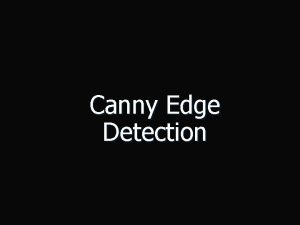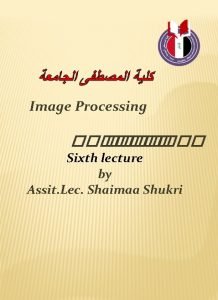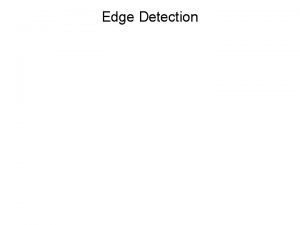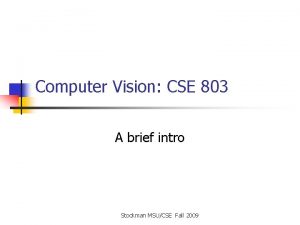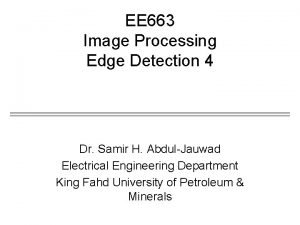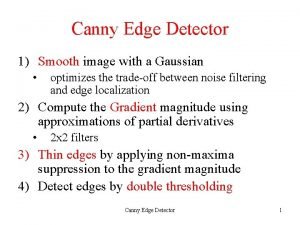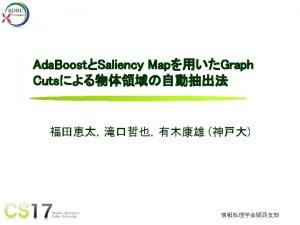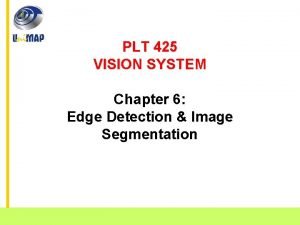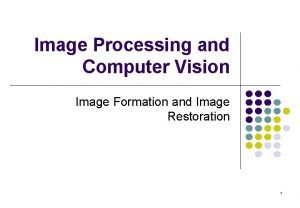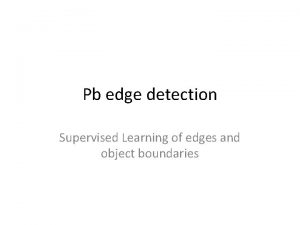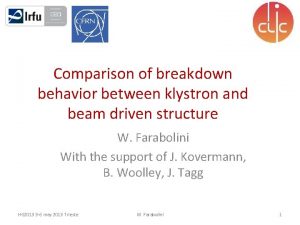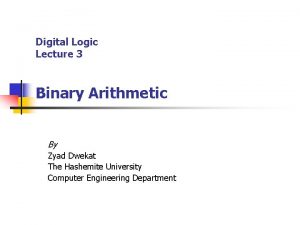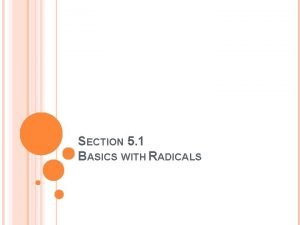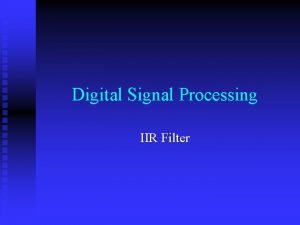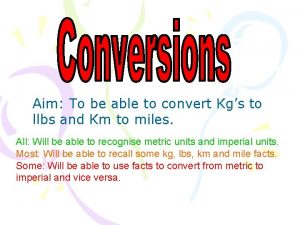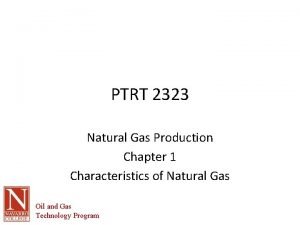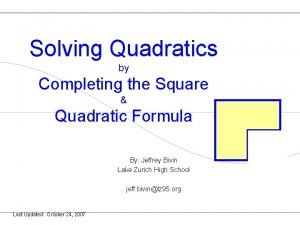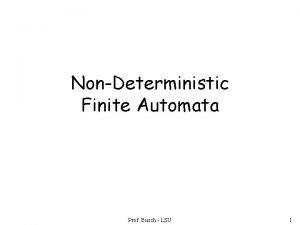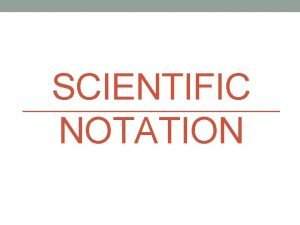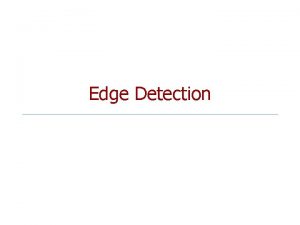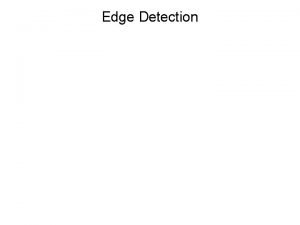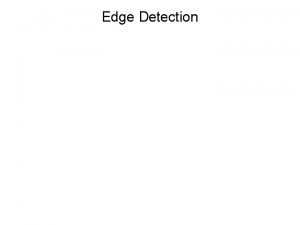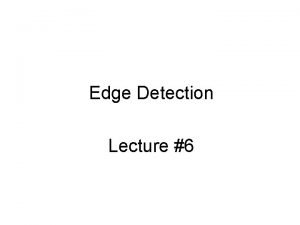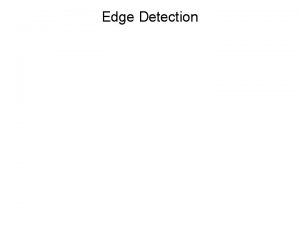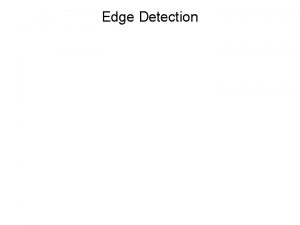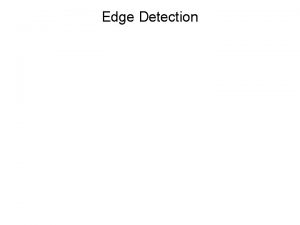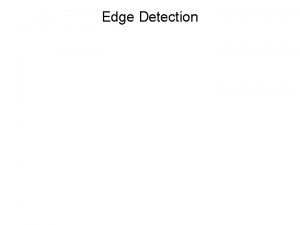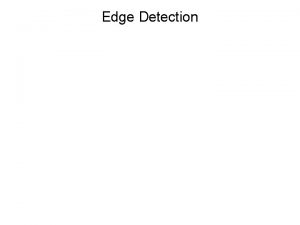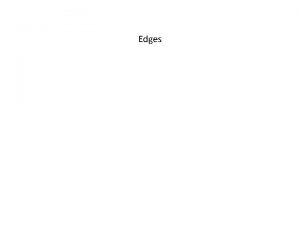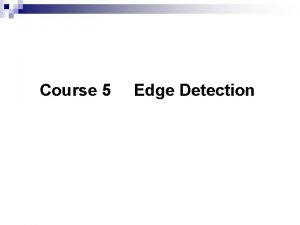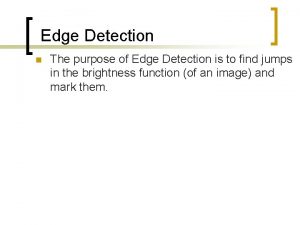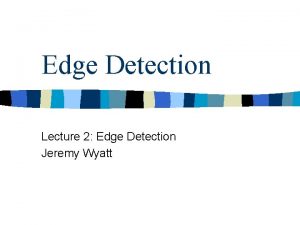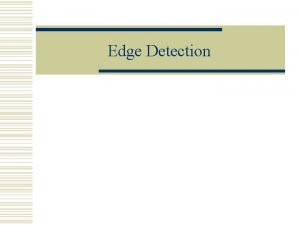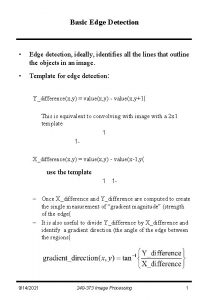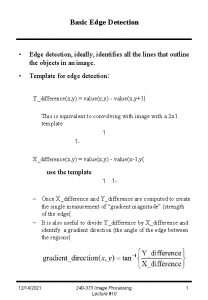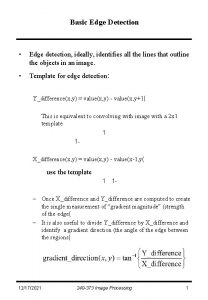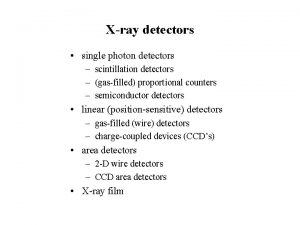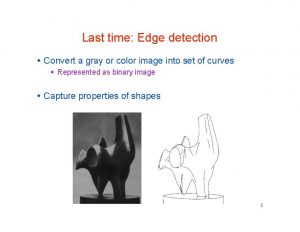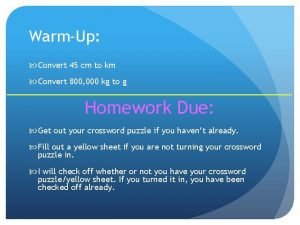Edge Detectors Edge Detection Convert a 2 D



































![Basic Hough Transform 1. Initialize H[d, θ]=0 2. for each edge point I[x, y] Basic Hough Transform 1. Initialize H[d, θ]=0 2. for each edge point I[x, y]](https://slidetodoc.com/presentation_image_h/0ef9d7360056542f1a49c0fdc22226a5/image-36.jpg)












- Slides: 48

Edge Detectors

Edge Detection • Convert a 2 D image into a set of curves ●Extracts salient features of the scene ●More compact than pixels 2

Edges • Edges are caused by a variety of factors surface normal discontinuity depth discontinuity surface color discontinuity illumination discontinuity 3

Edges • Edge is Where Change Occurs • Change is measured by derivative in 1 D • Biggest change, derivative has maximum magnitude • Or 2 nd derivative is zero. 4

Image Gradient • The gradient of an image: • The gradient points in the direction of most rapid change in intensity 5

Image Gradient • gradient direction • The edge strength • Discrete Gradient: by finite differences f(x+1, y) – f(x, y) f(x, y+1) – f(x, y) 6

Types of Edges 7

Sobel Operator • Better approximations of the derivatives ●Sobel operators -1 0 1 1 2 1 -2 0 0 0 -1 0 1 -1 -2 -1 • The standard def. of the Sobel operator omits the 1/8 term ●Doesn’t make a difference for edge detection ●The 1/8 term is needed to get the right gradient value 8

Sobel Operator - Result Original Convolution with Sobel Thresholding (Value = 64) Thresholding (Value = 96) 9

Noise - Effect 10

Solution: Smooth First 11

Derivative Theorem • This saves us one operation: 12

Result Without Gaussian With Gaussian 13

Second derivative • f(x+1, y) – 2 f(x, y) + f(x-1, y) • In 2 D • What is an edge? ●Look for zero crossings ●With high contrast ●Laplacian Kernel 14

Laplacian of Gaussian 15

2 D edge detection filters Laplacian of Gaussian derivative of Gaussian 16

Edge detection by subtraction original smoothed – original 17

Laplacian of Gaussian delta function Laplacian of Gaussian 18

Optimal Edge Detection: Canny • Assume: ●Linear filtering ●Additive Gaussian noise • Edge detector should have: ●Good Detection. Filter responds to edge, not noise. ●Good Localization: detected edge near true edge. ●Minimal Response: one per edge • Detection/Localization trade-off ●More smoothing improves detection ●And hurts localization. 19

Canny Edge Detector • Suppress Noise • Compute gradient magnitude and direction • Apply Non-Maxima Suppression ●Assures minimal response • Use hysteresis and connectivity analysis to detect edges 20

Non-Maxima Suppression • Edge occurs where gradient reaches a maxima • Suppress non-maxima gradient even if it passes threshold • Only eight directions possible ●Suppress all pixels in each direction which are not maxima ●Do this in each marked pixel neighborhood 21

Hysteresis • Avoid streaking near threshold value • Define two thresholds – L , H ●If less than L, not an edge ●If greater than H, strong edge ●If between L and H, weak edge ●Analyze connectivity to mark is either non-edge or strong edge ●Removes spurious edges 22

Steps of Canny Edge Detector Original Gradient Magnitude Non-Maximum Suppression After Hysteresis 23

Comparison with Laplacian Based Original Curvature Based Canny 24

Effect of Smoothing (kernel size) original Canny with 25

Multi-resolution Edge Detection • Smoothing • Eliminates noise edges. • Makes edges smoother. • Removes fine detail. (Forsyth & Ponce)


fine scale, high threshold

coarse scale, high threshold

Coarse scale, low threshold

Identifying parametric edges • Can we identify lines? • Can we identify curves? • More general ●Can we identify circles/ellipses? • Voting scheme called Hough Transform

Hough Transform • Only a few lines can pass through (x, y) ●mx+b (x, y) • Consider (m, b) space • Red lines are given by a line in that space ●b = y – mx • Each point defines a line in the Hough space • Each line defines a point (since same m, b)

How to identify lines? • For each edge point ●Add intensity to the corresponding line in Hough space • Each edge point votes on the possible lines through them • If a line exists in the image space, that point in Hough space will get many votes and hence high intensity • Find maxima in Hough space • Find lines by equations y – mx+b

Example

Problem with (m, b) space • Vertical lines have infinite m • Polar notation of (d, θ) • d = xcosθ + ysinθ d θ (0, 0)
![Basic Hough Transform 1 Initialize Hd θ0 2 for each edge point Ix y Basic Hough Transform 1. Initialize H[d, θ]=0 2. for each edge point I[x, y]](https://slidetodoc.com/presentation_image_h/0ef9d7360056542f1a49c0fdc22226a5/image-36.jpg)
Basic Hough Transform 1. Initialize H[d, θ]=0 2. for each edge point I[x, y] in the image for θ = 0 to 180 d = xcosθ + ysinθ H[d, θ] += 1 3. Find the value(s) of (d, θ) for max H[d, θ] A similar procedure can be used for identifying circles, squares, or other shape with appropriate change in Hough parameterization.

Non-Linear Filters

Corner Detections • Corners have more lines passing through them than pixels on edges • Should be easier • But edge detectors fail – why? ●Right at corner, gradient is ill-defined ●Near corner, gradient has two different values

Moravec Operator • Self-similarity ●How similar are neighboring patches largely overlapping to me? • Most regions - Very similar • Edges - Not similar in one direction (perpendicular to edge) • Corners – not similar in any direction • Interest point detection – not only corners

Measuring self-similarity • SSD = Sum of squared differences • Corner is local maxima

Limitations • Sensitive to noise – Responds for isolated pixel • Larger patches for robustness

Limitations • Responds also to diagonal edges

Limitations • Anisotropic (Not rotationally invariant)

Harris & Stephens/Plessey Corner Detector • Consider the differential of the corner score with respect to direction • Describes the geometry of the image surface near the point (u, v)

How to find the corner? • The eigenvalues are proportional to the principal curvatures • If both small, no edge/corner • If one big and one small, edge • If both big, then corner

Rotationally Invariant • If w is Gaussian, then this is isotropic

Non-linear filters: Median filter • Replace by median of the neighborhood • No new gray levels • Removes the odd man out ●Good for outlier removal • Retains edges

Median filter
 What is thermal detector
What is thermal detector Nuclear detectors
Nuclear detectors Feature detectors
Feature detectors Streaming potential
Streaming potential Where are feature detectors located
Where are feature detectors located Detectors used in hplc
Detectors used in hplc Frontier detectors for frontier physics
Frontier detectors for frontier physics Vhv voltage detectors
Vhv voltage detectors Kinesthesis and vestibular sense
Kinesthesis and vestibular sense Giant wave detectors murmurs universe
Giant wave detectors murmurs universe Yodsawalai chodpathumwan
Yodsawalai chodpathumwan Photo detectors
Photo detectors Feature vectors
Feature vectors Gravitational wave hear murmurs universe
Gravitational wave hear murmurs universe Edge detection
Edge detection Edging nnn
Edging nnn Convolution edge detection
Convolution edge detection Edge detection
Edge detection Edge detection sobel
Edge detection sobel Canny mask
Canny mask Edge detection
Edge detection Edge detection
Edge detection What is canny edge detection in image processing
What is canny edge detection in image processing Edge detection segmentation
Edge detection segmentation Edge detection
Edge detection Edge detection
Edge detection Ocr thai
Ocr thai Texas instruments matlab
Texas instruments matlab Edge detection
Edge detection Rising edge and falling edge
Rising edge and falling edge Convert image to text
Convert image to text 2 2/3 as an improper fraction
2 2/3 as an improper fraction Convert the number 3910 to binary.
Convert the number 3910 to binary. Convert cfg to chomsky normal form
Convert cfg to chomsky normal form Convert impressions to grps
Convert impressions to grps Convert aim
Convert aim How to convert ketone to carboxylic acid
How to convert ketone to carboxylic acid How to convert y=a(x-h)^2+k into y=ax2+bx+c
How to convert y=a(x-h)^2+k into y=ax2+bx+c Ost to pdf
Ost to pdf Unit 11 radicals homework 5 dividing radicals day 1
Unit 11 radicals homework 5 dividing radicals day 1 Convert to floating point
Convert to floating point Iir filter design by approximation of derivatives
Iir filter design by approximation of derivatives Molecules to mass
Molecules to mass Grams to mol
Grams to mol Convert llbs to kg
Convert llbs to kg Standard condition for gas
Standard condition for gas Completing the quare
Completing the quare Nfa to dfa
Nfa to dfa Standard notation
Standard notation















